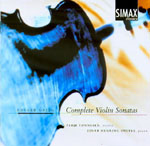Grieg characterized his three violin sonatas as “naïve, reflecting many antecedents” (No. 1), “national” (No. 2), and having “wider horizons” (No. 3). It’s noteworthy that he was right on the mark. Sonata No. 1 is highly influenced by the German school–particularly Schumann, whose own violin sonatas are brought to mind in Grieg’s impetuous first movement and finale (with its decidedly German main theme). No. 2 shifts its geographic focus sharply northward. The opening Lento doloroso, with its beautiful solo line, depicts the somber side of the Norwegian heart, then leads to a fiercely upbeat allegro. The following Allegretto’s theme at first may seem a quotation from the equivalent movement of Brahms’ Second Violin Sonata, but it rounds off in a manner that’s pure Grieg. The Finale is built upon those pounding parallel fifth chords that are a trademark of this composer.
Sonata No. 3 is the most rhapsodic of the three, and its second movement is a tender song of chiseled perfection, like one of the composer’s gentler lyric pieces. The finale is a rambunctious country dance, characterized by alternating major/minor modes. Violinist Terje Tonnesen wonderfully captures the precise mixture of rustic charm and sophisticated virtuosity necessary to allow this music to both touch the heart and engage the mind. Einar Henning Smebye proves a natural Grieg pianist, conveying the music’s moodiness and playfulness with equal agility. Simax’s recording, though a bit over-bright, creates an ideal balance between piano and violin.
































